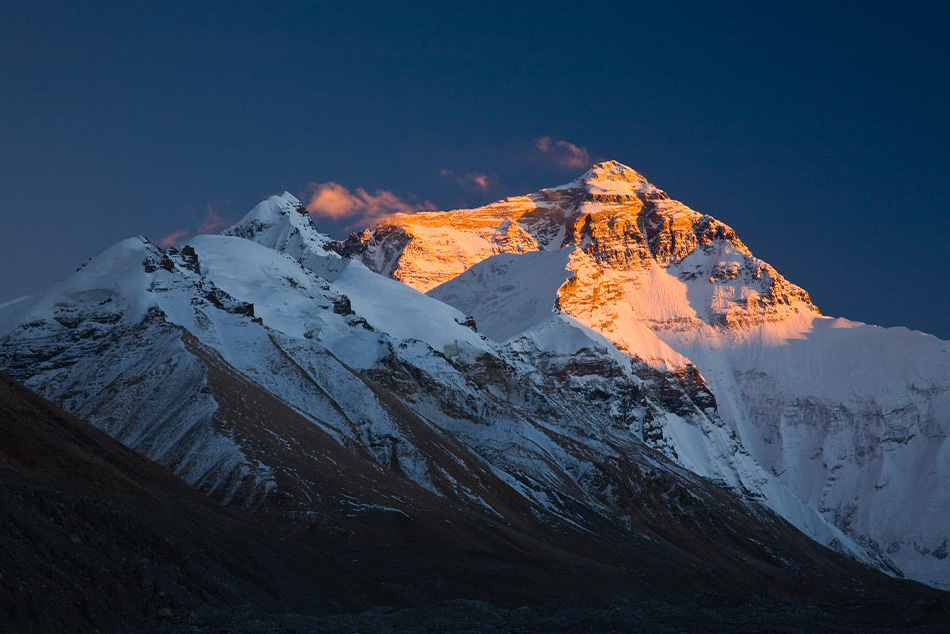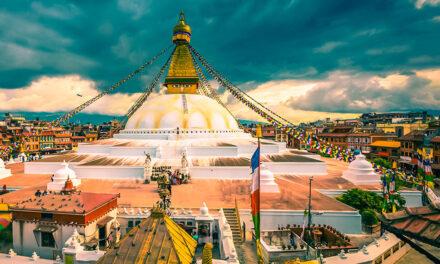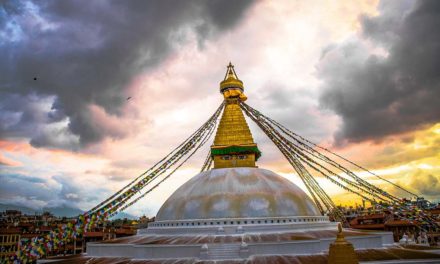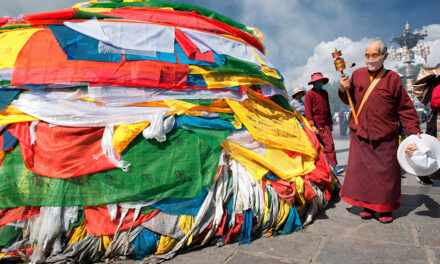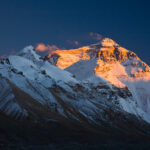Preventing Altitude Sickness at Everest Base Camp in Tibet. Tibet, often referred to as the “Roof of the World,” is a land of breathtaking landscapes, rich culture, and incredible adventures. Nestled in the heart of this enchanting region lies the Everest Base Camp (EBC), a destination that stands as a testament to nature’s grandeur and the indomitable spirit of human exploration. With an awe-inspiring altitude of approximately 5200 meters, EBC beckons to those who seek to touch the sky and embrace the extraordinary.
In this article, we embark on a journey to explore the majestic Tibet Everest Base Camp’s altitude, but we will go beyond the numbers. We’ll delve into the soul of this mystical place, uncovering the tales it holds and the challenges it presents. We’ll also equip you with invaluable insights on how to prepare for this high-altitude adventure, ensuring your safety and well-being.
As you embark on this virtual journey to EBC, let your imagination roam through its dramatic landscapes, where snow-capped peaks pierce the heavens, and pristine air fills your lungs. This article serves as your trusted guide, illuminating the path to not just physical altitude but also spiritual elevation, as you venture to the crown jewel of the Himalayas.
Understanding the Altitude at Tibet Everest Base Camp
Understanding the Altitude at Tibet Everest Base Camp goes beyond numbers; it’s about appreciating the awe-inspiring feat of nature and human endurance. At an elevation of around 5200 meters, the Tibet Everest Base Camp stands as a beacon for adventurers, a place where dreams of conquering the world’s tallest peak take shape. It’s not merely a destination; it’s an aspiration etched into the souls of explorers.
What makes this altitude particularly intriguing is its relative measurement. Comparing EBC’s lofty position at 5200 meters to Lhasa’s elevation of 3650 meters, it’s evident that you’re embarking on a journey that transcends typical travel experiences. The 1550-meter difference is more than just a number; it’s a gateway to the heavens, a challenge to embrace, and an opportunity to touch the sky.
For those who may wonder about the impact of this elevation, rest assured that it’s not an insurmountable hurdle. Most travelers who adapt well to the plateau environment at 3650 meters in Lhasa find the transition to 5200 meters at EBC manageable. It’s a testament to the resilience of the human body and the capacity to acclimate to new environments.
To assist you on this remarkable transition, our Lhasa to Everest Base Camp tour is thoughtfully designed. It begins with approximately three days in Lhasa, offering you a gentle introduction to the realm of high altitudes. During this time, you’ll explore the wonders of Lhasa, from the iconic Potala Palace to the vibrant Barkhor Street. These experiences not only enrich your understanding of Tibetan culture but also serve as a stepping stone towards acclimatization.
As you tread this path from Lhasa to EBC, you’re not merely covering geographical distance but traversing a spectrum of altitudes and emotions. You’ll breathe the crisp mountain air, witness the ever-changing landscapes, and inch closer to the towering peaks that beckon from the horizon.
So, as you prepare for your journey to Tibet Everest Base Camp, remember that it’s not just about scaling altitudes but about elevating your spirit, broadening your horizons, and embracing the extraordinary. This is a voyage that defies the ordinary, and with each step, you’re ascending not just in meters but in experiences and memories that will stay with you forever.
The Importance of Acclimatization
The Importance of Acclimatization cannot be overstated when preparing for a journey to high-altitude destinations like Tibet Everest Base Camp. It is, in many ways, the cornerstone of a safe and enjoyable adventure. The gradual adjustment to increasing altitudes not only minimizes the risk of altitude sickness but also allows you to savor every moment of this awe-inspiring journey.
Starting your expedition in the mesmerizing city of Lhasa is a strategic choice. Lhasa, standing at 3650 meters above sea level, is a vital stopover that paves the way for a seamless transition to higher altitudes. It provides an excellent opportunity for your body to acclimate naturally, allowing you to breathe in the rarefied air and absorb the cultural richness of this sacred city.
During your stay in Lhasa, the world-renowned attractions beckon you. The iconic Potala Palace, with its timeless grandeur, offers a glimpse into the spiritual heritage of Tibet. As you explore the Jokhang Temple, you’ll find yourself immersed in the bustling energy of the Barkhor Street, where centuries-old traditions meet modern life. The sprawling Drepung Monastery, known as the “Rice Heap Monastery,” invites you to delve into the spiritual heart of Tibet.
This initial stage of your journey is more than just acclimatization; it’s a captivating introduction to the diverse and vibrant culture that makes Tibet a unique destination. As you absorb the spiritual essence of Lhasa, you’ll find yourself growing not only in altitude but also in the depth of your travel experience.
Continuing from Lhasa to Tibet Everest Base Camp, you’ll likely take a route that leads you through the enchanting landscapes surrounding the sacred Lake Yamdrok Tso. This pristine, turquoise lake is framed by majestic mountains, creating a visual masterpiece that will remain etched in your memory. The journey from Shigatse to EBC unfolds before you, promising an adventure that’s as much about the landscapes as it is about altitude.
While you marvel at the stunning scenery, you’re also further acclimatizing to the increasing altitude, ensuring a smoother and more enjoyable experience at Everest Base Camp. This route is carefully chosen to minimize the risk of altitude sickness, making your journey not just breathtaking but also safe and comfortable.
So, remember that your adventure is not just about ascending to greater heights; it’s about ascending to a deeper connection with a place that’s steeped in history, culture, and natural beauty. Acclimatization is your companion on this voyage, a process that allows you to savor every moment, breathe the thin mountain air, and relish the majestic landscapes. It’s the key to unlocking the wonders of Tibet Everest Base Camp while keeping you safe and sound.
Common Altitude Sickness Symptoms
Common Altitude Sickness Symptoms are a natural part of the high-altitude experience and can affect both seasoned travelers and novice explorers. It’s essential to recognize these symptoms to ensure your safety and well-being while journeying to Tibet Everest Base Camp.
For most travelers, the initial encounter with altitude manifests as a subtle disruption in sleep patterns. You may find yourself waking up more frequently during the night, which is one of the most common indicators of altitude sickness. The thin mountain air, while invigorating, may cause you to experience slightly reduced sleep quality. This is a common and manageable symptom, impacting more than 50% of tourists. It’s often a temporary adjustment period as your body adapts to the new environment.
In addition to disrupted sleep, around 40% of travelers may experience mild symptoms such as headaches and difficulty falling asleep. These symptoms are typically alleviated through rest and acclimatization. It’s essential to listen to your body during this phase and take it easy, allowing yourself to adjust at your own pace. Such mild symptoms are a common rite of passage for those journeying to higher altitudes.
However, it’s crucial to be aware of the more severe altitude sickness symptoms. These include unconsciousness, vomiting, and the appearance of bluish lips and nails. While these severe symptoms are rare, they should never be ignored. If you or a fellow traveler exhibit any of these signs, it’s a clear indication that immediate action is necessary. In such cases, it’s paramount to notify your travel guide and make the decision to evacuate from Everest Base Camp to lower altitudes for prompt medical attention. Safety always takes precedence, and being vigilant about these symptoms can make all the difference in ensuring a safe and memorable journey.
Altitude sickness is not a one-size-fits-all experience. It’s a spectrum of symptoms that may manifest differently in each individual. While mild symptoms are a common occurrence and can be managed through rest and acclimatization, severe symptoms require immediate attention. Your awareness and proactive response to these symptoms will enhance your overall journey, allowing you to appreciate the magic of Tibet Everest Base Camp while keeping your health and well-being a top priority.
Preventive Measures Before Your Journey
Preventive Measures Before Your Journey are the foundation upon which your high-altitude adventure to Tibet Everest Base Camp is built. These proactive steps ensure that you embark on your journey with confidence and readiness, fully prepared to embrace the extraordinary experiences that await you.
First and foremost, consider this initial phase as an investment in your well-being. Spend quality time resting and adapting to the high-altitude climate. Whether you choose to acclimate in the cultural haven of Lhasa at 3650 meters or in Shigatse at 3845 meters, this period of adjustment is a critical component of your journey. It’s your passport to a smoother transition to higher altitudes, allowing your body to acquaint itself with the rarified air and the breathtaking landscapes.
Maintaining a positive and optimistic attitude is more than just an encouragement; it’s a strategy. Your mental disposition has a significant impact on how your body responds to high altitudes. Positivity not only enhances your resilience but also enriches your overall travel experience. With each step, you’ll find yourself growing stronger, both physically and emotionally, ready to face the challenges and rewards of your ascent.
As you set out on your adventure, remember that haste is not your ally. Avoid strenuous exercise and embrace the art of leisurely exploration. Walk at a comfortable pace, especially as you ascend to higher altitudes. This unhurried approach not only conserves your energy but also allows you to fully appreciate the beauty that surrounds you. Each step is a brushstroke on the canvas of your adventure.
In high-altitude regions, the air is often drier, making hydration a crucial aspect of your journey. Drinking at least 1500 milliliters of water daily, equivalent to three bottles of mineral water, keeps your body nourished and helps alleviate symptoms of altitude sickness. It’s the elixir that sustains your spirit and vitality.
Additionally, your diet is your source of energy, especially in the cold and energy-demanding environment of Everest Base Camp. While you may experience bloating and a reduced appetite upon reaching EBC, it’s essential to continue eating. A balanced diet is your ally, providing the necessary nourishment and strength to navigate the heights. There’s no need to overindulge; feeling 70% full is sufficient, as overeating may lead to digestive discomfort.
These preventive measures are the pillars of your preparation for the high-altitude adventure that awaits you. They are the guardian angels of your health, well-being, and enjoyment. By embracing acclimatization, a positive mindset, measured activity, hydration, and a balanced diet, you are not just preparing for a journey; you are ensuring that every moment of your ascent to Tibet Everest Base Camp is enriched and memorable.
Dealing with Altitude Sickness
Dealing with Altitude Sickness is an essential skill to master as you prepare for your ascent to Tibet Everest Base Camp. It’s a testament to your commitment to safety and the ability to navigate the challenges that high altitudes may present.
When mild symptoms of altitude sickness, such as mild shortness of breath, dizziness, and headaches, make their presence felt, the best strategy is a breath of fresh air. Stepping outside of the tent, where the air is crisp and invigorating, can swiftly alleviate the symptoms of oxygen deprivation. The tents and lodges, often filled with fellow travelers, may not provide the optimal environment for recovery. Inhaling the pure mountain air is your refuge, offering relief from the discomfort and signaling to your body that you’re in control.
For those experiencing moderate symptoms, which may include persistent headaches, dizziness, and shortness of breath, a more systematic approach may be necessary. Consider measuring your oxygen saturation levels, a practical gauge of your well-being at high altitudes. If these levels indicate a need for intervention, oxygen therapy is your ally. It provides a controlled and steady supply of oxygen, serving as a lifeline to alleviate breathing difficulties and headache issues. Oxygen therapy is not just a treatment; it’s a source of reassurance, ensuring that your journey remains on course.
However, it’s imperative to be vigilant for the most severe altitude sickness symptoms. When loss of consciousness, repeated vomiting, or the alarming appearance of bluish lips and nails occurs, it’s a call for immediate action. There is no room for hesitation. Your first step should be to contact your travel guide, whose expertise and guidance are invaluable. Swiftly make the decision to evacuate from Everest Base Camp to lower-altitude areas. It’s a path to safety, where the symptoms will begin to recede rapidly, and medical attention can be administered without delay. In these moments, your priorities are clear: health, safety, and the peace of mind that you’ve taken the necessary steps to ensure your well-being.
In dealing with altitude sickness is not just a skill; it’s a responsibility. It’s a partnership between you, your guide, and the environment. With a proactive approach to mild symptoms, a systematic response to moderate symptoms, and swift action for severe symptoms, you’re prepared to embrace the beauty of Tibet Everest Base Camp while safeguarding your health. It’s a journey filled with highs, and your approach to altitude sickness ensures that those highs are the ones that inspire awe, not concern.
Preparing for a Safe Trip
Preparing for a Safe Trip to Tibet Everest Base Camp involves taking a few extra precautions to ensure that your journey is not just memorable but also entirely safe. These added measures are your insurance policy for a smooth and hassle-free experience.
Before you embark on your journey to the Roof of the World, consider scheduling a comprehensive medical check-up. This prudent step helps to rule out any underlying health issues that could pose a concern during your high-altitude adventure. Health concerns, such as cardiovascular problems, can be addressed and managed, ensuring that you are well-prepared for the challenges that lie ahead.
A consultation with a healthcare professional is another crucial aspect of your preparation. This consultation is not just a formality; it’s an opportunity to gather expert advice and recommendations. Your healthcare professional can guide you in preparing a medical kit that includes 1-2 types of anti-altitude sickness medications, such as Rhodiola and Diamox. These medications, under professional guidance, can prove to be your allies in combating altitude sickness and ensuring a smooth ascent to Everest Base Camp.
In addition to anti-altitude sickness medications, it’s prudent to carry a few extra medical supplies that can be a lifeline if needed. Items like glucose and high-altitude aids can be essential in addressing specific symptoms and ensuring that your health remains in top condition during your journey.
For the initial two days of your Tibet tour, it’s advisable to forego showers. While cleanliness is important, bathing in high-altitude areas can have unintended consequences, including catching a cold. Colds and fevers, when experienced in high-altitude regions, can serve as triggers or exacerbate altitude sickness. Thus, a brief pause in showering is a preventive measure that minimizes risks and keeps you on the path to a remarkable journey.
These additional measures are not just safeguards but the cornerstones of your preparation for a safe and enjoyable adventure to Tibet Everest Base Camp. They ensure that your health and well-being are well-preserved, allowing you to immerse yourself fully in the awe-inspiring landscapes and rich culture of Tibet. With these precautions in place, your journey is poised to be an unforgettable and health-conscious experience.
Exploring Tibet’s Everest Base Camp
Exploring Tibet’s Everest Base Camp is a multifaceted adventure that goes beyond the challenges of altitude and acclimatization. It’s a journey that invites you to delve into the heart of a unique culture, witness the grandeur of the Himalayas, and experience the profound spirituality that permeates the region.
As you ascend to the high-altitude plateau of Tibet, you’ll be immersed in a world where ancient traditions and a deep sense of spirituality are interwoven into the fabric of everyday life. The people of Tibet are known for their warm hospitality and their devotion to Buddhism. Exploring the local monasteries and interacting with monks provides a profound insight into the spiritual essence that defines this region. The iconic Potala Palace, a UNESCO World Heritage Site, stands as a testament to the rich history and cultural significance of Tibet. It’s a place where you can explore the architectural marvels of Tibetan Buddhism and gaze at stunning panoramic views of Lhasa.
The journey to Everest Base Camp is also a visual feast for nature enthusiasts. The stark, breathtaking landscapes of Tibet, from the tranquil shores of Lake Yamdrok Tso to the majestic vistas of the Himalayas, unfold before your eyes. The azure waters of Lake Yamdrok Tso, often called the “Turquoise Lake,” glisten in the high-altitude sun, surrounded by snow-capped peaks. The journey to Everest Base Camp offers a front-row seat to the wonders of nature, and each step you take brings you closer to the towering magnificence of Mount Everest.
Moreover, the local culture is vibrant and captivating. The colorful prayer flags fluttering in the wind, the melodious sound of Tibetan chants, and the bustling markets where you can engage with local artisans are all part of the experience. The Barkhor Street in Lhasa is a bustling market where you can immerse yourself in the local culture, shop for traditional Tibetan handicrafts, and savor local delicacies.
Your journey to Tibet Everest Base Camp is not just an adventure of the body but also a journey of the soul. It’s a unique opportunity to connect with the spiritual, cultural, and natural wonders of this extraordinary land. By embracing both the challenges of altitude and the rewards of exploration, you’ll create lasting memories and experiences that are as awe-inspiring as the landscapes themselves.
The Rich Culture and Scenery
The Rich Culture and Scenery of Tibet are a mesmerizing blend of tradition and natural beauty, making your visit to Everest Base Camp not just a high-altitude adventure but a profound cultural and visual journey.
Tibet’s vibrant culture is deeply rooted in Buddhism, and as you explore Everest Base Camp, you’ll have the chance to immerse yourself in the spiritual heartbeat of this region. The local monasteries, with their intricate architectural designs and serene surroundings, provide an opportunity to witness the dedication of Tibetan monks to their faith. These monasteries are not just places of worship; they are living repositories of centuries-old wisdom and tradition.
Prayer flags, a ubiquitous sight in Tibet, are a visual manifestation of the spiritual significance of the region. The colorful flags, often adorned with prayers and mantras, flutter in the high-altitude breeze, carrying the hopes and aspirations of the Tibetan people to the heavens. Each flag is a testament to the deep spirituality that permeates the land, and you can participate in this ritual by hanging your own prayer flags, adding a personal touch to the ancient tradition.
The Tibetan people themselves are known for their warm hospitality and genuine smiles. Engaging with locals, whether it’s sharing a cup of yak butter tea or participating in traditional ceremonies, offers a window into the rich and diverse culture of Tibet. The chance to interact with Tibetan families and learn about their way of life is an experience that transcends language barriers and leaves a lasting impression.
The stunning landscapes of Tibet are equally captivating. From the tranquil shores of Lake Yamdrok Tso, often referred to as the “Turquoise Lake,” to the towering Himalayan peaks, every moment is a visual feast. The azure waters of Lake Yamdrok Tso contrast with the surrounding snow-capped mountains, creating a picture-perfect scene. This sacred lake is not only a place of natural beauty but also a destination for spiritual pilgrimages.
As you make your way to Everest Base Camp, the Himalayan range slowly reveals itself, offering breathtaking panoramic views. The world’s highest peak, Mount Everest, stands tall and proud, a sight that leaves an indelible mark on your memory.
In summary, Tibet’s rich culture and scenery are intertwined, creating a tapestry of experiences that enrich your journey to Everest Base Camp. It’s a destination where the spiritual and the natural coexist in perfect harmony, and your exploration of both promises to be a deeply fulfilling and memorable adventure.
Getting the Most Out of Your Trip
Getting the Most Out of Your Trip to Tibet Everest Base Camp involves not only witnessing the stunning landscapes and rich culture but also actively engaging in local activities that offer a profound insight into Tibetan life.
Meditation sessions with monks are a unique opportunity to immerse yourself in the spiritual essence of Tibet. Tibetan Buddhism is renowned for its meditative practices, and joining a session with monks allows you to experience firsthand the tranquility and mindfulness that are integral to their way of life. The monasteries and temples provide serene settings for these sessions, where you can find inner peace and a deeper connection with the spiritual world.
Participating in traditional ceremonies is another way to connect with the heart of Tibetan culture. Whether it’s witnessing the colorful and intricate rituals at a local monastery or being part of an authentic Tibetan ceremony, these experiences offer a glimpse into the deeply ingrained traditions that shape Tibetan life. It’s a chance to not just observe but to be an active participant in a cultural tapestry that is centuries old.
Indulging in Tibetan tea, particularly yak butter tea, is a delightful aspect of your journey. This unique beverage is not just a drink but a symbol of Tibetan hospitality and tradition. Sharing a cup of yak butter tea with locals is a gesture of friendship and a way to connect with the warmth and generosity of the Tibetan people. It’s an experience that goes beyond taste, offering a cultural connection that lingers in your memories.
These activities are not just add-ons to your journey; they are gateways to a deeper understanding of Tibetan life and culture. By actively engaging in meditation, participating in ceremonies, and savoring traditional tea, you enrich your trip and create lasting memories that transcend the boundaries of language and distance. In the end, getting the most out of your visit to Tibet Everest Base Camp means not just being a spectator but an active participant in the world you are exploring.
Experiencing Local Cuisine
Experiencing Local Cuisine in Tibet is a journey of flavors that connects you to the heart of Tibetan culture. The local food is more than just sustenance; it’s an integral part of the rich tapestry of traditions that define this region. As you explore Tibet Everest Base Camp, you’ll discover a delectable array of dishes that not only tantalize your taste buds but also tell stories of heritage and hospitality.
Momo, the beloved Tibetan dumplings, are a must-try delicacy. These bite-sized delights come in various forms, from steamed to fried, and are often filled with a mixture of meat and vegetables. Momo is more than just a food; it’s a cultural symbol of gathering and sharing. Enjoying these delectable treats with locals is an opportunity to connect over a shared plate and create lasting memories.
Yak meat, a staple of Tibetan cuisine, is a flavor that embodies the high-altitude landscapes of Tibet. The lean and tender meat is often used in a variety of dishes, from stir-fries to stews. Savoring yak meat is not just a culinary adventure; it’s a way to appreciate the resourcefulness of the Tibetan people, who have adapted to the harsh conditions of the plateau with a diet that sustains them in the thin mountain air.
Thukpa, a hearty noodle soup, is another treat that warms both the body and the soul. It’s a comfort food that offers respite from the chilly mountain weather and nourishes you with its wholesome ingredients. Whether you opt for a vegetarian version or one with meat, thukpa is a flavorful journey that reflects the diversity of Tibetan cuisine.
Exploring local cuisine is not just about taste; it’s a cultural immersion that allows you to connect with the Tibetan way of life. Dining in local eateries, engaging with chefs, and sharing meals with fellow travelers are experiences that foster a deep appreciation for the traditions and flavors of Tibet. It’s a journey for the senses, where every bite tells a story, and every meal is a celebration of the rich heritage that defines this remarkable region.
Exploring Nearby Attractions
Exploring Nearby Attractions around Everest Base Camp offers a comprehensive experience that goes beyond the iconic base camp itself. The surrounding region is a treasure trove of cultural and natural wonders, each adding a layer of richness to your journey.
Rongbuk Monastery, nestled in the dramatic landscapes of Tibet, is a spiritual haven at one of the world’s highest altitudes. It’s not just a place of worship but also a residence for some of the world’s highest-altitude monks. Visiting this sacred site provides a unique glimpse into the spiritual practices and daily lives of these dedicated individuals. The monastery’s architecture, adorned with traditional Tibetan elements, is a sight to behold and a testament to the enduring influence of Buddhism in the region.
The surrounding landscapes offer endless opportunities for photography and the chance to bask in pristine natural beauty. From Everest Base Camp, you can capture breathtaking vistas of the Himalayan peaks, including the towering Mount Everest. The play of light and shadows on these majestic mountains, especially during sunrise and sunset, creates a mesmerizing spectacle. The pristine surroundings also offer a glimpse into the rugged terrain and unique flora and fauna that thrive in this high-altitude environment.
For those with a spirit of adventure, nearby attractions provide the perfect backdrop for trekking and hiking. The trails offer varying levels of difficulty, allowing you to tailor your exploration to your preferences and fitness level. These treks lead to panoramic viewpoints, serene lakes, and hidden valleys, each offering a distinct facet of the Himalayan wilderness.
Engaging with the local communities in the vicinity is another rewarding aspect of your journey. Interacting with nomadic families, learning about their traditional way of life, and understanding their close relationship with the environment provide insights into the resilience and adaptability of the Tibetan people.
In conclusion, exploring the nearby attractions around Everest Base Camp transforms your journey into a multi-faceted adventure that encompasses culture, spirituality, nature, and adventure. It’s an opportunity to go beyond the ordinary and immerse yourself fully in the extraordinary landscapes and rich traditions that make Tibet Everest Base Camp a destination like no other.
Where to Stay
Choosing the Right Accommodation at Everest Base Camp is an essential consideration that can significantly impact your journey. The options range from simple lodges at the base camp to more comfortable choices in the nearby Tashi Dzong Township. Your decision will depend on factors like your acclimatization, preferences, and travel companions.
Staying at Everest Base Camp itself offers the unparalleled experience of being in the heart of the world’s highest mountain range. The base camp lodges, while basic, provide a rustic charm and proximity to the iconic Mount Everest. For well-acclimatized travelers and adventure enthusiasts, these lodges can be a suitable choice, providing you with the raw and unfiltered beauty of the high-altitude environment. While the accommodations are simple, the opportunity to be in such close proximity to the world’s highest peak is a unique and awe-inspiring experience.
For those seeking more comfort and breathtaking views of Mount Everest, Tashi Dzong Township is an excellent option. This township is situated at a lower elevation, around 4200 meters, making it a more comfortable choice for travelers who want to enjoy the scenery without experiencing the extreme altitude of Everest Base Camp. The accommodations here offer a range of options, from cozy guesthouses to more upscale hotels. Staying in Tashi Dzong Township not only provides you with comfortable lodging but also ensures you’re well within the safety zone for altitude-related issues.
If you’ve acclimatized well and are looking for an immersive experience, you can also consider staying at Rongbuk Monastery. This option not only offers a unique spiritual experience but also puts you in close proximity to the base camp, allowing for easy exploration. The tent hostels at the Mount Everest Base Camp are another budget-friendly option for those who are confident in their acclimatization and looking to minimize costs.
Ultimately, the choice of accommodation at Everest Base Camp should align with your level of acclimatization, personal preferences, and the overall goals of your journey. Whether you opt for the simplicity of the base camp lodges, the comfort of Tashi Dzong Township, the unique experience at Rongbuk Monastery, or the budget-friendly tent hostels, your accommodation should enhance your experience of this remarkable destination.
Packing Tips for Tibet
Packing for your journey to Tibet Everest Base Camp requires careful consideration of the high-altitude environment and its ever-changing weather conditions. Here are some essential packing tips to ensure you’re well-prepared for this remarkable adventure:
- Layered Clothing: Dressing in layers is key to adapting to the fluctuating temperatures at high altitudes. Start with moisture-wicking base layers to keep you dry and warm. Add insulating layers like fleece or down jackets for warmth, and top it off with a waterproof and windproof outer layer to shield you from the elements. This layering system allows you to adjust your clothing according to the weather and your activity level.
- Warm Accessories: Don’t forget to pack essential accessories like gloves, a beanie or hat, and a good quality scarf. These items are crucial for keeping your extremities warm, as they are often the first to feel the chill in cold conditions.
- Sturdy Footwear: Invest in a pair of sturdy and comfortable hiking boots with good ankle support. The terrain around Everest Base Camp can be uneven, and proper footwear will ensure your safety and comfort during treks and hikes.
- Sunglasses and Sunscreen: The high-altitude sun can be intense, and UV radiation is stronger at higher elevations. Bring high-quality sunglasses with full UV protection to shield your eyes. Additionally, apply sunscreen generously to protect your skin from sunburn.
- Backpack: A comfortable and appropriately sized backpack is essential for carrying your daily essentials, such as water, snacks, extra layers, and your camera. Look for a backpack with adjustable straps to ensure a good fit and even weight distribution.
- Medications and First Aid: It’s wise to carry a small first-aid kit with essentials like adhesive bandages, pain relievers, and any personal medications you may need. While trekking, it’s also beneficial to have blister prevention items on hand.
- Water and Hydration: Staying well-hydrated is crucial at high altitudes. Carry a reusable water bottle or a hydration system to ensure you have access to clean drinking water throughout your journey. Also, consider packing water purification tablets or a water filter for additional safety.
- Travel Documents: Double-check that you have all the necessary travel documents, including your passport, visa, and any permits required for your trip to Tibet.
- Cash and Currency: ATMs may be limited in the region, so it’s essential to carry enough local currency for your expenses. Keep your cash in a secure and waterproof pouch.
- Travel Adapters and Chargers: Tibet uses unique power outlets, so bring a travel adapter for your electronic devices. Don’t forget chargers for your cameras, phones, and other gadgets, as you’ll want to capture the stunning landscapes.
- Snacks and Energy Food: High-energy snacks like energy bars, nuts, and dried fruits are handy for quick boosts of energy during treks and hikes. Having a stash of these in your backpack can be a lifesaver when you need a quick refuel.
- Travel Insurance: Ensure you have comprehensive travel insurance that covers high-altitude activities and emergency medical evacuation. This gives you peace of mind in case of unexpected situations.
By following these packing tips, you’ll be well-equipped to face the challenges and embrace the beauty of Tibet Everest Base Camp. Remember that preparation is key, and being ready for the ever-changing weather conditions and high-altitude environment allows you to make the most of your journey.
Conclusion of Preventing Altitude Sickness at Everest Base Camp in Tibet
In conclusion, embarking on a journey to Tibet Everest Base Camp is embarking on an adventure like no other. The stunning landscapes, vibrant culture, and the allure of the world’s highest peak make this destination a dream come true for travelers seeking remarkable experiences. While altitude sickness may pose a challenge, the measures outlined in this guide are your companions in ensuring a safe and memorable journey. As you acclimate gradually, adapt to the high-altitude climate, and take proactive steps to deal with any symptoms, you’ll find yourself well-prepared to embrace the wonders of the Roof of the World.
Exploring the rich culture, breathtaking scenery, and partaking in unique experiences at Tibet Everest Base Camp will fill your travel album with indelible memories. The spiritual significance of the monasteries, the warmth of the Tibetan people, and the panoramic vistas of the Himalayan range all contribute to an extraordinary adventure. Your journey here is not just about altitude; it’s about immersing yourself in a land of wonder, beauty, and culture. It’s a voyage that leaves an indelible mark on your heart and spirit, ensuring that your memories of this awe-inspiring destination will last a lifetime.
FAQs of Preventing Altitude Sickness at Everest Base Camp in Tibet
What is the best time to visit Tibet Everest Base Camp?
The best time to visit Tibet Everest Base Camp is during the late spring and early autumn, from April to June and September to November. During these months, you can expect milder temperatures, clear skies, and relatively stable weather conditions. The views of Mount Everest and the surrounding landscapes are at their most stunning during this period.
Are there any age restrictions for visiting Everest Base Camp?
There are no strict age restrictions for visiting Everest Base Camp, but it’s essential to consider the physical fitness and health of individuals, especially at high altitudes. Travelers of all ages, including children and seniors, have visited EBC. However, it’s recommended that older individuals and young children are well-prepared and in good health to cope with the altitude and the journey.
Can I get oxygen support at Everest Base Camp if I experience altitude sickness?
Yes, most accommodations at Everest Base Camp provide oxygen support to guests who experience altitude sickness. They have oxygen tanks and masks available for use. Additionally, trained staff can offer assistance and guidance if you are feeling unwell due to altitude. It’s crucial to notify your guide or the accommodation staff if you experience any altitude-related symptoms.
What should I do if I have a pre-existing medical condition?
If you have a pre-existing medical condition, it’s highly advisable to consult with your healthcare provider before embarking on a journey to Tibet Everest Base Camp. Your healthcare provider can assess your condition and provide recommendations for managing your health at high altitudes. They may also offer guidance on the suitability of the trip for your specific medical condition.
How do I book a tour to Tibet Everest Base Camp with I-Tibet Travel & Tours?
Booking a tour with I-Tibet Travel & Tours is a straightforward process. You can visit their official website or contact their customer service to explore tour options, itineraries, and pricing. Once you’ve selected a tour that suits your preferences, you can make a reservation and secure your spot. I-Tibet Travel & Tours will provide you with the necessary information and support to ensure a smooth and memorable journey to Tibet Everest Base Camp.

